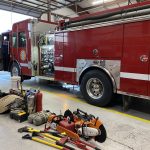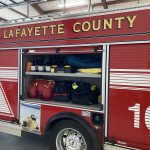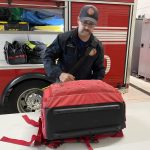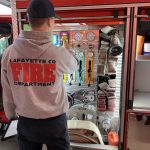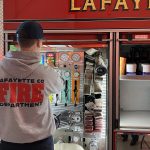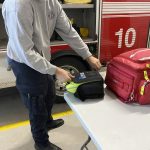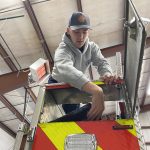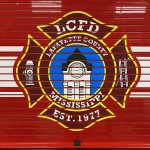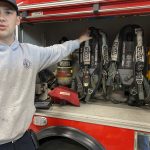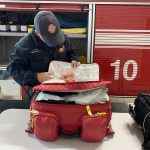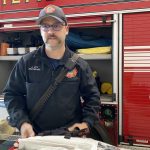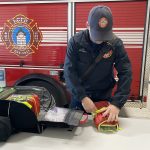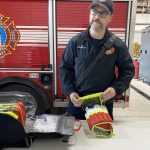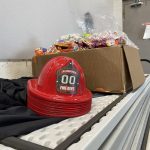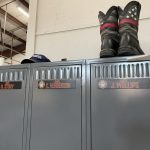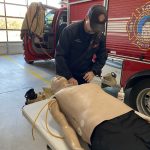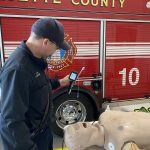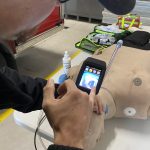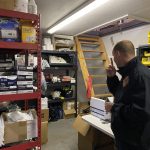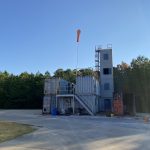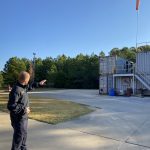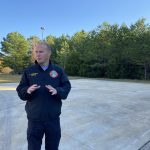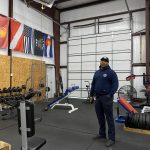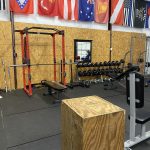County News
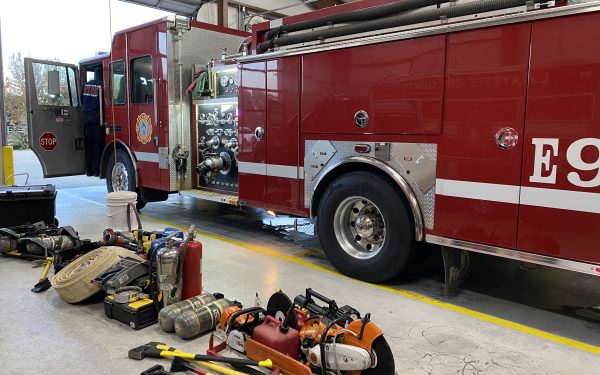
Casey Henderson started carrying his fire radio at 16.
Shortly after his first fire call—which he responded to along with his dad and uncle, both volunteers on the force in Grenada, Miss.—he realized firefighting would be his life’s work.
In those early days, Henderson admits, the radio was an excuse to occasionally rush out of class to something far more exciting. But it also was the chance to save lives, to serve the community that had raised him.
“To see those guys get off a tractor in the middle of a field and run to the fire station to try and help somebody, and somebody run out of a factory covered in soot,” Henderson said, “I was like, ‘This is what my small town is about. This is what I’m supposed to do.’”
Nowadays, Henderson serves as one of the Lafayette County Fire Department’s full-time captains. He hopes to do this 10 or 20 more years, far past his retirement age.
No Two Days the Same—Except the Preparation
Around 7 a.m. on the second day of his crew’s 48-hour shift, Henderson finishes his breakfast. The first day, the team had responded to a rollover on Highway 30 and extinguished a grass fire in Taylor.
In terms of sleep, the night before had been a good one. A call just before midnight took them away from the station—and their beds—for about half an hour. They then slept soundly until dawn.
Now wide-awake, the crew is preparing for the day. John Michael Hill, a LCFD firefighter, is doing his daily walkthrough of the station’s trucks and their equipment.
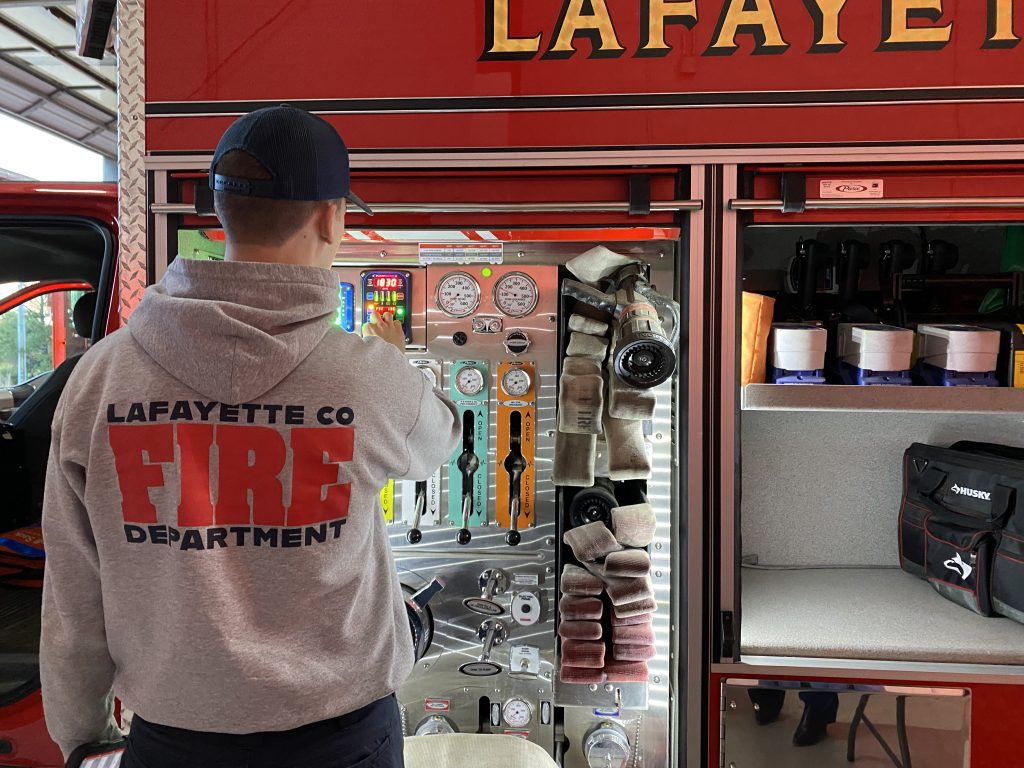
He checks all the gear on the truck—from simple emergency blankets that can end up in the wrong place during the chaos of a call to self-contained breathing apparatuses (air packs), which could spell disaster if they aren’t working correctly.
The air packs, which cost about $7,500 each, are an indispensable part of keeping firefighters safe during a blaze. Henderson said he’s thankful the County has invested even in less noticeable equipment like this.
“We’re pretty fortunate here to rely on the County and not rely strictly on a hope that we’ll get a grant from the government year in and year out,” he said.
Hill also inspects the three types of jaws of life, one of which has a spreading force of 134,900 pounds, and the cribbing used to protect patients while raising a vehicle or structure. He marks each item off a digital list on his tablet as he goes.
Lieutenant Jamie Roy—who, like Henderson, has volunteered since high school and has a long family lineage in firefighting—is doing the same with his medical gear. A certified paramedic, Roy went through two additional years of training after becoming EMT.
“We can give drugs, medications, do IVs, intubate people, and use the manual defibrillator and cardiac monitors,” he said. “It’s a lot more capabilities.”
In Roy’s medical bag, one finds a toolkit for saving lives, first aid supplies to treat trauma patients, a video and a manual laryngoscope, and secondary airway devices to help patients breathe and save them from choking. Among many other drugs, Narcan in the case of an opioid overdose.
The Adrenaline Rush of a Call
As Roy is checking his medical bag, a call comes in over the radio. It’s a vehicle accident. Roy is ready to respond but realizes it’s in the city limits of Oxford and the Oxford Fire Department will take that call. Now the anticipation for the next call.
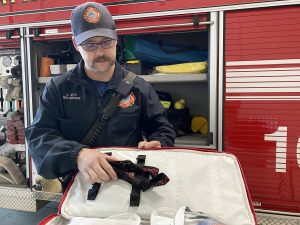
In Roy, you can see that odd mix of duty and fearlessness that pulses through the psyche of a firefighter. It’s part of the training. “The mental rebuild,” Henderson calls it.
Larry Brown, the late bard of Oxford-area firefighters, knew it, too, and put it down in writing.
“I love to drive to any incident, love to run the siren, to run fast but careful through town,” he wrote in his memoir On Fire. “I love the smell of smoke and the feeling of fear that comes on me when I see that a fire is already through the roof and licking at the sky because I know that I am about to be tested again, my muscles, my brain, my heart.”
A firefighter’s job is to be dangerous and courageous and crazy enough to enter burning buildings, all to save strangers’ lives.
“At the end of the day, my job is to make sure I don’t have to go knock on somebody’s door and tell them that their husband or their son passed away,” Henderson said.
This singular goal changes how firefighters treat one another. In the firehouse, Henderson said, conflicts are quickly set aside when lives are on the line.
“If a call comes in a minute later and that guy’s trapped in a house and that other guy knows, ‘I’m probably gonna have the skin burned off me, have a roof collapse on me,’ there’s not gonna be a second thought about going in to save that guy,” he said. “That’s the difference in the firehouse from somewhere else.”
Help Is on the Way
Soon enough, Roy does get his call. Over their radios, the details are relayed: a medical patient, on the other side of the county. In seconds, Roy and Hill have their things together and, with sirens blaring, are on their way out.
These days, most calls are medical. They range from falls and other accidents to heart attacks and breathing issues. As code enforcement in Lafayette County has improved, Henderson said, there are fewer fires overall. Yet, as Lafayette County’s population has grown, more people need medical care.
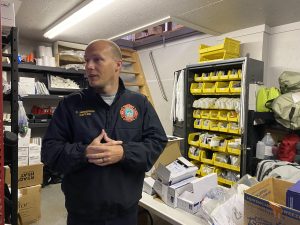
The LCFD force—composed of full-time, part-time and paid-per-call firefighters—has become adept at responding to these calls, oftentimes arriving well before the ambulances.
“We got a code—cardiac arrest right up the road. … We started CPR. We intubated. We put in an IV. We pushed a couple drugs,” Roy said. “That lady had a pulse back before the ambulance even showed up.”
In turn, the County has made a substantial investment in medical equipment and personnel. There are paramedics like Roy on each shift, and all firefighters are trained as EMRs or EMTs.
Medical calls don’t typically have the high drama of a blazing building, Henderson said, but they save lives, and that’s what matters.
“If someone across the street is having a heart attack and we can be there in two minutes, where an ambulance is 13 minutes—and we can have compressions, an IV and meds already being pushed—it greatly increases the odds of survivability,” he said.
Although medical response makes up the bulk of their work, the LCFD is on call for all sorts of things: boater rescues on the lake, hazardous materials response, rope rescues, search and rescue efforts, first aid at Ole Miss sporting events and, of course, fighting fires.
Adding More Resources
The County is currently in the process of building a two-story expansion, which will connect to LCFD’s Central Station and add more space for bedrooms. Henderson, however, is most excited about the fact that he’ll have a fire pole.
“I’ve never had a fire station in 18 years with a fire pole,” he said. “That was the first thing I asked the chief … I’m so excited about the fire pole, even though one day I’ll probably mess my hip up, make me retire early as I slide down it at 3 a.m.”
LCFD is also investing in updating the training facilities. The updated space will be designed like a house with stud walls, sheetrock and furniture a firefighter might find in different rooms. The walls can be moved around, making the training course more challenging—and more true-to-life.
Facing the Fire
Training, however, has it limits. Henderson recalls a time in an extremely hot fire this year in Lafayette County that he entered with two newer firefighters. It was so hot that, as he went to respond to the incident commander, his mic began to melt in his hand.
“I could feel my face burning,” Henderson said.
Henderson and the others eventually got out of the house. A seasoned firefighter, he had felt his limit—and the younger firefighters certainly did too. This generational knowledge is something training drills alone can never teach, and this particular fire was a great teacher.
“If they never got to feel that, and they were in there not with someone experienced to know it, they may have come out way earlier,” he said. “You can keep pushing to find that victim, to find the seat of the fire to put it out.”

